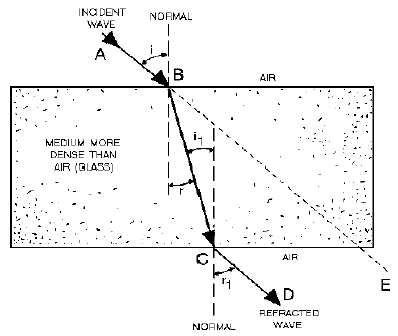1-15
Figure 1-10.—Refraction of a wave.
To summarize what figure 1-10 shows:
1. If the wave passes from a less dense medium to a more dense medium, it is bent toward the
normal, and the angle of refraction (r) is less than the angle of incidence (i).
2. If the wave passes from a more dense to a less dense medium, it is bent away from the normal,
and the angle of refraction (r1) is greater than the angle of incidence (i1).
You can more easily understand refraction by looking at figure 1-11. There is a plowed field in the
middle of a parade ground. Think of the incident wave as a company of recruits marching four abreast at
an angle across the parade ground to the plowed field, then crossing the plowed field and coming out on
the other side onto the parade ground again. As the recruits march diagonally across the parade ground
and begin to cross the boundary onto the plowed field, the front line is slowed down. Because the recruits
arrive at the boundary at different times, they will begin to slow down at different times (number 1 slows
down first and number 4 slows down last in each line). The net effect is a bending action. When the
recruits leave the plowed field and reenter the parade ground, the reverse action takes place.


